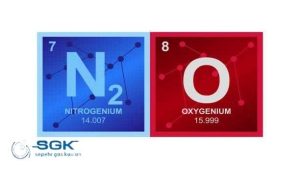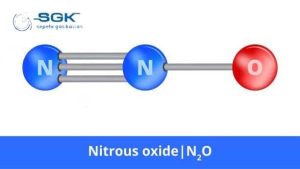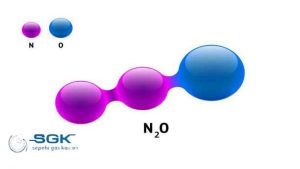Nitrous oxide gas
Nitrous oxide (N2O), also known as laughing gas, nitrous, nitro, or nos, is a chemical compound, an oxide of nitrogen with the formula N₂O. At room temperature, it is a colorless non-flammable gas, and has a slightly sweet scent and taste.
Sepehr Gas Kavian Company is able to supply nitrous dioxide gas in the volume of cylinders – capsules: 2 liter cylinder (150 bar) – 5 liter cylinder (150 bar), 10 liter cylinder (150 bar) – 20 liter cylinder (150 bar), cylinder 40 liter (150 bar) – 50 liter (200 bar) cylinder, the purity percentage or charge grade of domestic this gas is 99.999mol%, 99.99mol%, 99.9995mol% and for imported this gas is 99.999mol% and 99.9999mol% . And for the first time in Iran, it is able to produce combined gases and gas mixtures with a percentage of either ppm or ppb of nitrous oxide.

Nitrous oxide gas (N2O) is available in grades 99, 99.9, 99.99, 99.998, 99.999.
Nitrous oxide gas (N2O) 99% for anesthesia is available in a 40-liter cylinder with a quantity of 20 kg.
Nitrous oxide gas (N2O) 99.9% (Atomic absorption) is available in a 40 liter cylinder with an amount of 20 kg and in a 50 liter cylinder with an amount of 25 kg.
Nitrous oxide gas (N2O) 99.99% (Atomic absorption) is available in a 40 liter cylinder with an amount of 20 kg and in a 50 liter cylinder with an amount of 25 kg.
Nitrous oxide gas (N2O) 99.998% (Atomic absorption) is available in a 40 liter cylinder with an amount of 20 kg and in a 50 liter cylinder with an amount of 25 kg.
Nitrous oxide gas (N2O) 99.999% (Atomic absorption) is available in a 40 liter cylinder with an amount of 20 kg and in a 50 liter cylinder with an amount of 25 kg.
Resources
The main sources of N2O emissions are:
Agriculture: This gas is produced in soils when organic matter is broken down by bacteria. The amount of nitrous oxide produced depends on the type of soil, the amount of fertilizer used, and the management practices used.
Fuel combustion: This gas is produced when fossil fuels are burned, such as in power plants, vehicles, and industrial processes.
Wastewater treatment: N2O is produced during the treatment of wastewater, such as in sewage treatment plants.
Industrial processes: This gas is produced in a variety of industrial processes, such as the production of nitric acid and fertilizers.
Natural sources: This gas is also produced naturally by some bacteria and algae.

Technical specification
| Chemical formula | N2O |
| Molecular weight | 44.01 g/mol |
| Boiling point | -89.5 °C (-128.1 °F) |
| Melting point | -90.8 °C (-131.4 °F) |
| Density | 1.966 g/L (at STP) |
| Vapor pressure | 745 psi (51.7 atm) at 20 °C (68 °F) |
| Color | Colorless |
| Odor | Slightly sweet |
| Flammability | Non-flammable |
| Toxicity | Moderately toxic |
Application
(N2O) is a colorless, odorless gas that has a wide variety of applications. Some of the most common uses of nitrous oxide include:
Medical/dental anesthesia and analgesia. This gas is a versatile anesthetic that can be used for both minor and major surgical procedures. It is also used in dentistry to provide pain relief and relaxation.
Food processing propellant. This gas is a common propellant in whipped cream canisters and other food products. It is also used in the production of other food products, such as ice cream and frozen yogurt.
Semiconductor manufacturing. N2O is used in the manufacturing of semiconductors. It is used to etch away the silicon dioxide layer on a wafer, which allows for the creation of transistors and other electronic components.
Analytical chemistry. N2O is used in analytical chemistry as a reducing agent. It is also used to create nitric oxide, which is a gas that is used in a variety of analytical applications.
Chemical manufacturing. This gas is used in the production of a variety of chemicals, including nitric acid, adipic acid, and nylon.
Auto racing engine injection. N2O is sometimes injected into the air intake of a car’s engine to increase its power output. This is a common practice in drag racing and other motorsports.
In addition to these common uses, this gas has a number of other applications in the medical, industrial, and scientific fields. It is a versatile gas with a wide range of potential uses.
Here are some of the safety precautions that should be taken when using nitrous oxide:
N2O is a compressed gas, so it should be handled with care.
This gas can be flammable, so it should not be used near open flames or other sources of ignition.
This gas can displace oxygen, so it should not be used in enclosed spaces.
This gas can cause dizziness, lightheadedness, and other side effects, so it should be used with caution.

Danger
Improper or careless use of compressed gases may be dangerous and lead to side effects and health problems. Some of the dangers associated with improper use of N2O include:
- Lack of oxygen: excessive use of this gas can lead to a decrease in the level of oxygen in the body. This can lead to dizziness, nausea, shortness of breath, and in more severe cases, collapse and loss of consciousness.
- Cardiovascular effects: Improper use of this gas laughing gas may lead to high blood pressure (hypertension) and heart failure. People who have heart or vascular problems should avoid using this gas.
- Respiratory effects: Excessive use of this gas can lead to shortness of breath and breathing problems. This can be dangerous for people with breathing problems, especially when exposed to high amounts of gas.
- Allergic sensitivities: Some people may be allergic to laughing gas and experience symptoms such as asthma, shortness of breath, itching and redness of the skin. In case of sensitivity, the use of this gas should be done carefully and with the doctor’s advice.
- Possibility of fire: nitrous oxide laughing gas may be flammable under certain conditions. Therefore, the use of this gas should be avoided near fire sources or in flammable situations.





